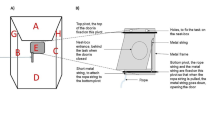Summary
Wheel-running activity was recorded in male golden hamsters (Mesocricetus auratus) that had been blinded by bilateral enucleation and then kept singly in cages in a continuously darkened cabinet (room 1). In an adjacent cabinet (room 2), sighted male and female hamsters were kept in a 12:12-h light-dark cycle. For time spans varying from 15 to 45 days, two females within their cages were transferred for 3 h each day from room 2 to room 1 at the same time of light-off in room 2. Afterwards, two sighted male hamsters were transferred to room 1 for 3 h each day for 28 days. For the last 70 days of the experiment, all blinded males were transferred permanently to room 2. There were three main results: (1) bilateral enucleation of the males in room 1 had no effect on phase or period of the free-running rhythm; (2) the rhythms of the blinded males were entrained neither by the 3-h daily presence of two females nor after the transfer into room 2; (3) the presence of females usually released activity in the males depending on the circadian phase at which the exposure to females occurred. The masking responses were maximal at the beginning of the activity time, and reached a minor second maximum approximately 9 to 12 h later.
Similar content being viewed by others
References
Aschoff J (1960) Exogenous and endogenous components in cireadian rhythms. Cold Spring Harbor Symp Quant Biol 25:11–28
Aschoff J (1988) Masking of circadian rhythms by zeitgebers as opposed to entrainment. In: Reitveld WJ (ed) Proc XVIII International Conference on Chronobiology Pergamon, New York (in press)
Aschoff J, Daan S, Honma K (1982) Zeitgebers, entrainment, and masking: some unsettled questions. In: Daan S, Groos G (eds) Vertebrate circadian systems: structure and physiology. Springer, Berlin Heidelberg New York, pp 13–24
Aschoff J, von Goetz C (1987a) Masking of circadian activity rhythms in hamsters by darkness. J Comp Physiol 162:559–562
Aschoff J, von Goetz C (1987b) Masking of circadian activity rhythms in canaries by light and dark. J Biol Rhythms (in press)
Bovet J, Oertli EF (1974) Free-running circadian activity rhythms in free-living beaver (Castor canadensis). J Comp Physiol 92:1–10
Crowley M, Bovet J (1980) Social synchronization of circadian rhythms in deer mice (Peromycus maniculatus). Behav Ecol Sociobiol 7:99–105
Davis FC, Stice S, Menaker M (1987) Activity and reproductive state in the hamster: independent control by social stimuli and a circadian pacemaker. Physiol Behav 40:583–590
DeCoursey P (1960) Phase control of activity in a rodent. Cold Spring Harbor Symp Quant Biol 25:49–54
Durant EP (1935) Influence of the female white rat on bodily activity of the male. Am J Physiol 113:37
Erkert HG, Nagel B, Stephani I (1986) Light and social effects on the free-running circadian activity rhythm in common marmosets (Callithrix jacchus; Primates): social masking, pseudo-splitting, and relative coordination. Behav Ecol Sociobiol 18:443–452
Erkert HG, Schardt U (1988) Soziale Synchronisation der circadianen Aktivitätsperiodik beim Weißbüscheläffchen, Callithrix jacchus. In: Schmidt Th (ed) Abstr 61. Hauptvers Dtsch Ges Säugetierkunde, Parey, Berlin (in press)
Gwinner E (1966) Entrainment of a circadian rhythm in birds by species-specific song cycles (Aves, Fringillidae: Carduelis spinus, Serinus serinus). Experientia 22:765
Hemmingsen S (1932) Studies on the oestrus producing hormone (oestrin). Skand Arch Physiol 65:97–250
Hiroshige T, Honma K, Watanabe K (1982) Possible zeitgebers for external entrainment of the circadian rhythm of plasma corticosterone in blinded infantile rats. J Physiol (London) 325:507–519
Kleinknecht S (1985) Lack of social entrainment of free-running circadian activity rhythms in the Australian sugar glider (Petaurus breviceps: Marsupialia). Behav Ecol Sociobiol 16:189–193
Marimuthu G, Subbaraj R, Chandrashekaran MK (1978) Social synchronization of the activity rhythm in cave-dwelling bat. Naturwissenschaften 65:6000
Marimuthu G, Subbaraj R, Chandrashekaran MK (1981) Social entrainment of the circadian rhythm in the flight activity of the microchiropteran bat Hipposideros speoris. Behav Ecol Sociobiol 8:147–150
Menaker M, Eskin A (1966) Entrainment of circadian rhythms by sound in Passer domesticus. Science 154:1579–1581
Morin LP, Fitzgerald KM, Zucker I (1977) Estradiol shortens the period of hamster circadian rhythms. Science 196:305–306
Pittendrigh CS, Daan S (1976) A functional analysis of circadian pacemakers in nocturnal rodents. V. Pacemaker structure: A clock for all seasons. J Comp Physiol 106:333–335
Slonaker JR (1935) Sex-drive in rats. Am J Physiol 112:176–181
Södersten P, Hansen S, Srebro B (1981) Suprachiasmatic lesions disrupt the daily rhythmicity in the sexual behaviour of normal male rats and of male rats treated neonatally with antioestrogen. J Endocr 88:125–130
Sulzman FM, Fuller CA, Moore-Ede MC (1977) Environmental synchronizers of squirrel monkey circadian rhythms. J Appl Physiol 43:795–800
Swann J, Turek FW (1982) Cycle of lordosis behavior in female hamsters whose circadian activity rhythm has split into two components. Am J Physiol 12:R112-R118
Author information
Authors and Affiliations
Rights and permissions
About this article
Cite this article
Aschoff, J., von Goetz, C. Masking of circadian activity rhythms in male golden hamsters by the presence of females. Behav Ecol Sociobiol 22, 409–412 (1988). https://doi.org/10.1007/BF00294978
Received:
Accepted:
Issue Date:
DOI: https://doi.org/10.1007/BF00294978




